Joint Ventures and Formal Dispute Resolution in UK Construction
VerifiedAdded on 2020/10/05
|36
|12694
|362
Report
AI Summary
This report investigates the relationship between the increasing prevalence of joint ventures within the UK construction industry and the subsequent impact on the requirement for formal dispute resolution mechanisms. The research begins with an introduction to the background, aims, objectives, and rationale of the study, emphasizing the significance of the investigation and its scope. A comprehensive literature review explores the concepts of formal and informal dispute resolution, the issues associated with formal methods, and the potential for joint ventures to reduce the need for adjudication. The methodology outlines the research design, philosophy, approach, techniques, sampling, data collection, and analysis methods, alongside ethical considerations and measures for validity and reliability. The data analysis section presents descriptive statistics and regression analysis. The findings and discussion are followed by conclusions and recommendations, offering insights into the evolving dynamics of dispute resolution within the UK construction sector. The report aims to assess whether the rise in joint ventures has led to a shift towards informal dispute resolution methods, and if so, the implications of this change.
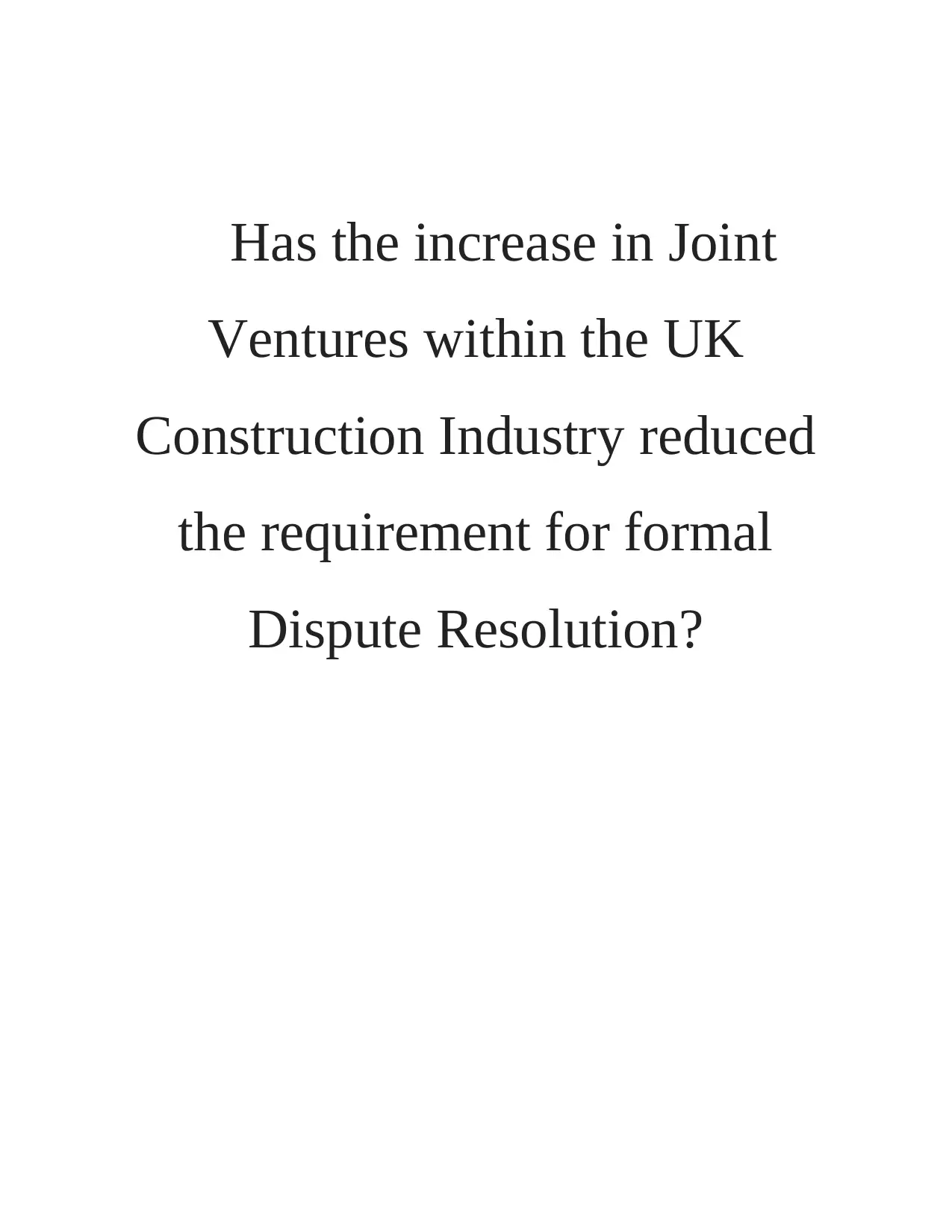
Has the increase in Joint
Ventures within the UK
Construction Industry reduced
the requirement for formal
Dispute Resolution?
Ventures within the UK
Construction Industry reduced
the requirement for formal
Dispute Resolution?
Paraphrase This Document
Need a fresh take? Get an instant paraphrase of this document with our AI Paraphraser
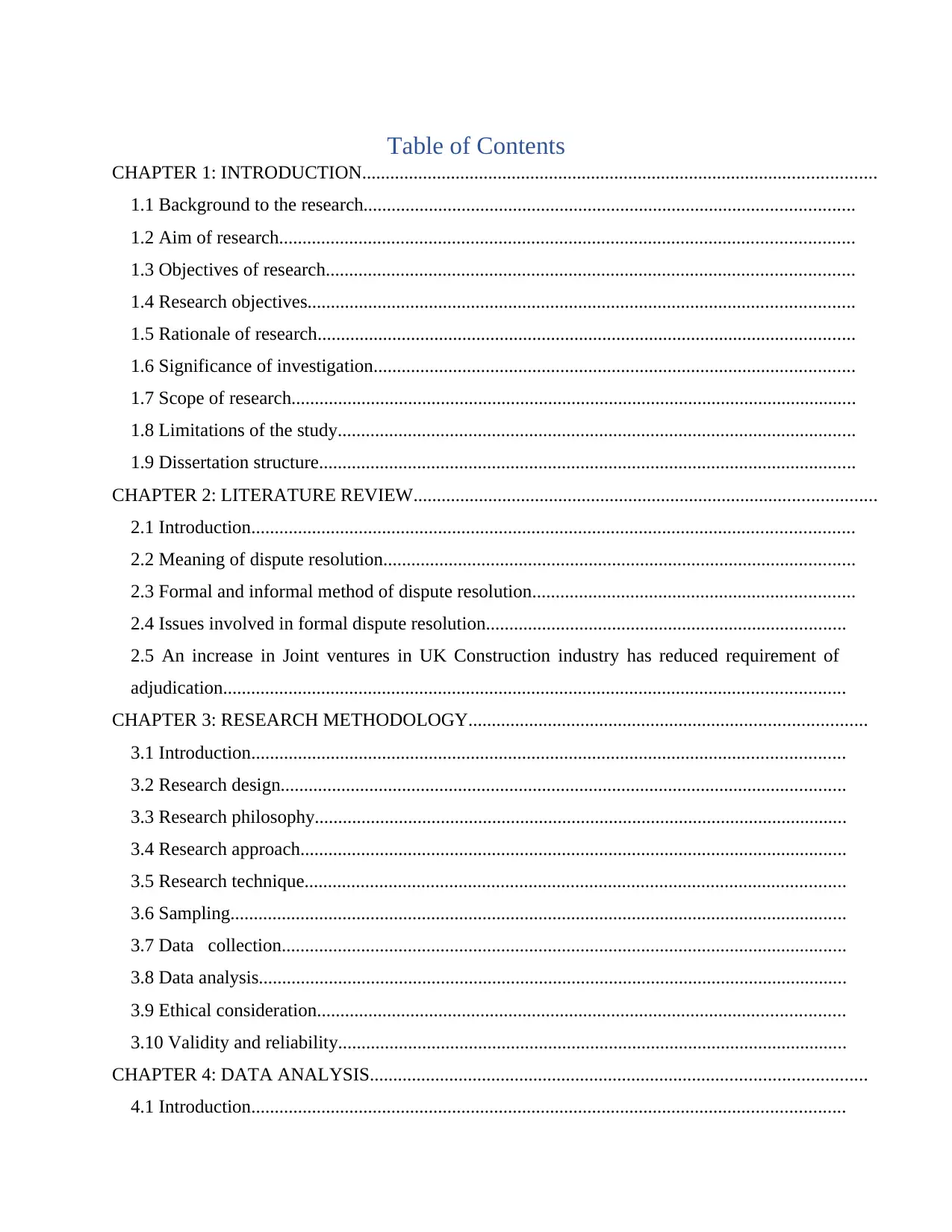
Table of Contents
CHAPTER 1: INTRODUCTION..............................................................................................................
1.1 Background to the research.........................................................................................................
1.2 Aim of research...........................................................................................................................
1.3 Objectives of research.................................................................................................................
1.4 Research objectives.....................................................................................................................
1.5 Rationale of research...................................................................................................................
1.6 Significance of investigation.......................................................................................................
1.7 Scope of research.........................................................................................................................
1.8 Limitations of the study...............................................................................................................
1.9 Dissertation structure...................................................................................................................
CHAPTER 2: LITERATURE REVIEW...................................................................................................
2.1 Introduction.................................................................................................................................
2.2 Meaning of dispute resolution.....................................................................................................
2.3 Formal and informal method of dispute resolution.....................................................................
2.4 Issues involved in formal dispute resolution.............................................................................
2.5 An increase in Joint ventures in UK Construction industry has reduced requirement of
adjudication.....................................................................................................................................
CHAPTER 3: RESEARCH METHODOLOGY.....................................................................................
3.1 Introduction...............................................................................................................................
3.2 Research design.........................................................................................................................
3.3 Research philosophy..................................................................................................................
3.4 Research approach.....................................................................................................................
3.5 Research technique....................................................................................................................
3.6 Sampling....................................................................................................................................
3.7 Data collection.........................................................................................................................
3.8 Data analysis..............................................................................................................................
3.9 Ethical consideration.................................................................................................................
3.10 Validity and reliability.............................................................................................................
CHAPTER 4: DATA ANALYSIS..........................................................................................................
4.1 Introduction...............................................................................................................................
CHAPTER 1: INTRODUCTION..............................................................................................................
1.1 Background to the research.........................................................................................................
1.2 Aim of research...........................................................................................................................
1.3 Objectives of research.................................................................................................................
1.4 Research objectives.....................................................................................................................
1.5 Rationale of research...................................................................................................................
1.6 Significance of investigation.......................................................................................................
1.7 Scope of research.........................................................................................................................
1.8 Limitations of the study...............................................................................................................
1.9 Dissertation structure...................................................................................................................
CHAPTER 2: LITERATURE REVIEW...................................................................................................
2.1 Introduction.................................................................................................................................
2.2 Meaning of dispute resolution.....................................................................................................
2.3 Formal and informal method of dispute resolution.....................................................................
2.4 Issues involved in formal dispute resolution.............................................................................
2.5 An increase in Joint ventures in UK Construction industry has reduced requirement of
adjudication.....................................................................................................................................
CHAPTER 3: RESEARCH METHODOLOGY.....................................................................................
3.1 Introduction...............................................................................................................................
3.2 Research design.........................................................................................................................
3.3 Research philosophy..................................................................................................................
3.4 Research approach.....................................................................................................................
3.5 Research technique....................................................................................................................
3.6 Sampling....................................................................................................................................
3.7 Data collection.........................................................................................................................
3.8 Data analysis..............................................................................................................................
3.9 Ethical consideration.................................................................................................................
3.10 Validity and reliability.............................................................................................................
CHAPTER 4: DATA ANALYSIS..........................................................................................................
4.1 Introduction...............................................................................................................................
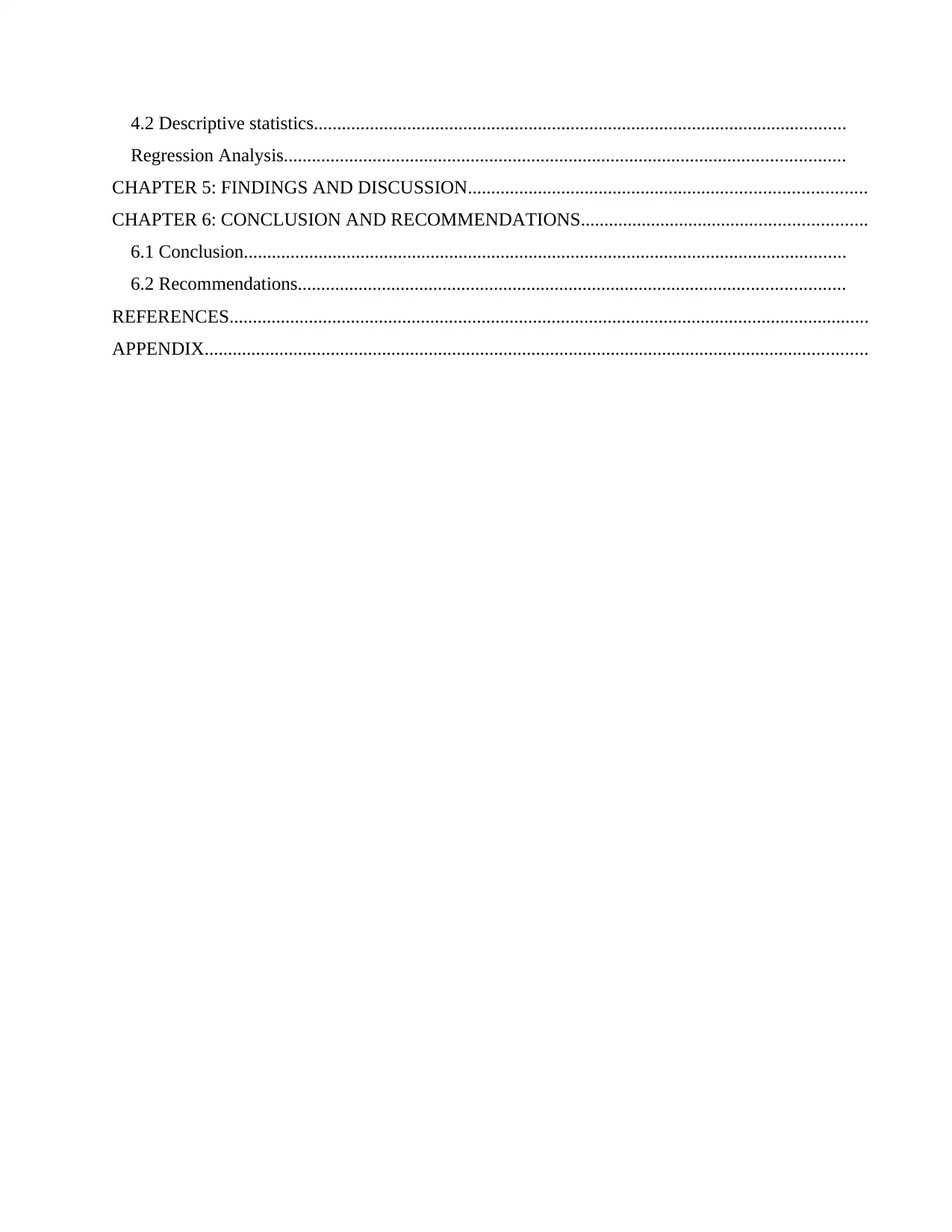
4.2 Descriptive statistics..................................................................................................................
Regression Analysis........................................................................................................................
CHAPTER 5: FINDINGS AND DISCUSSION.....................................................................................
CHAPTER 6: CONCLUSION AND RECOMMENDATIONS.............................................................
6.1 Conclusion.................................................................................................................................
6.2 Recommendations.....................................................................................................................
REFERENCES.........................................................................................................................................
APPENDIX..............................................................................................................................................
Regression Analysis........................................................................................................................
CHAPTER 5: FINDINGS AND DISCUSSION.....................................................................................
CHAPTER 6: CONCLUSION AND RECOMMENDATIONS.............................................................
6.1 Conclusion.................................................................................................................................
6.2 Recommendations.....................................................................................................................
REFERENCES.........................................................................................................................................
APPENDIX..............................................................................................................................................
⊘ This is a preview!⊘
Do you want full access?
Subscribe today to unlock all pages.

Trusted by 1+ million students worldwide
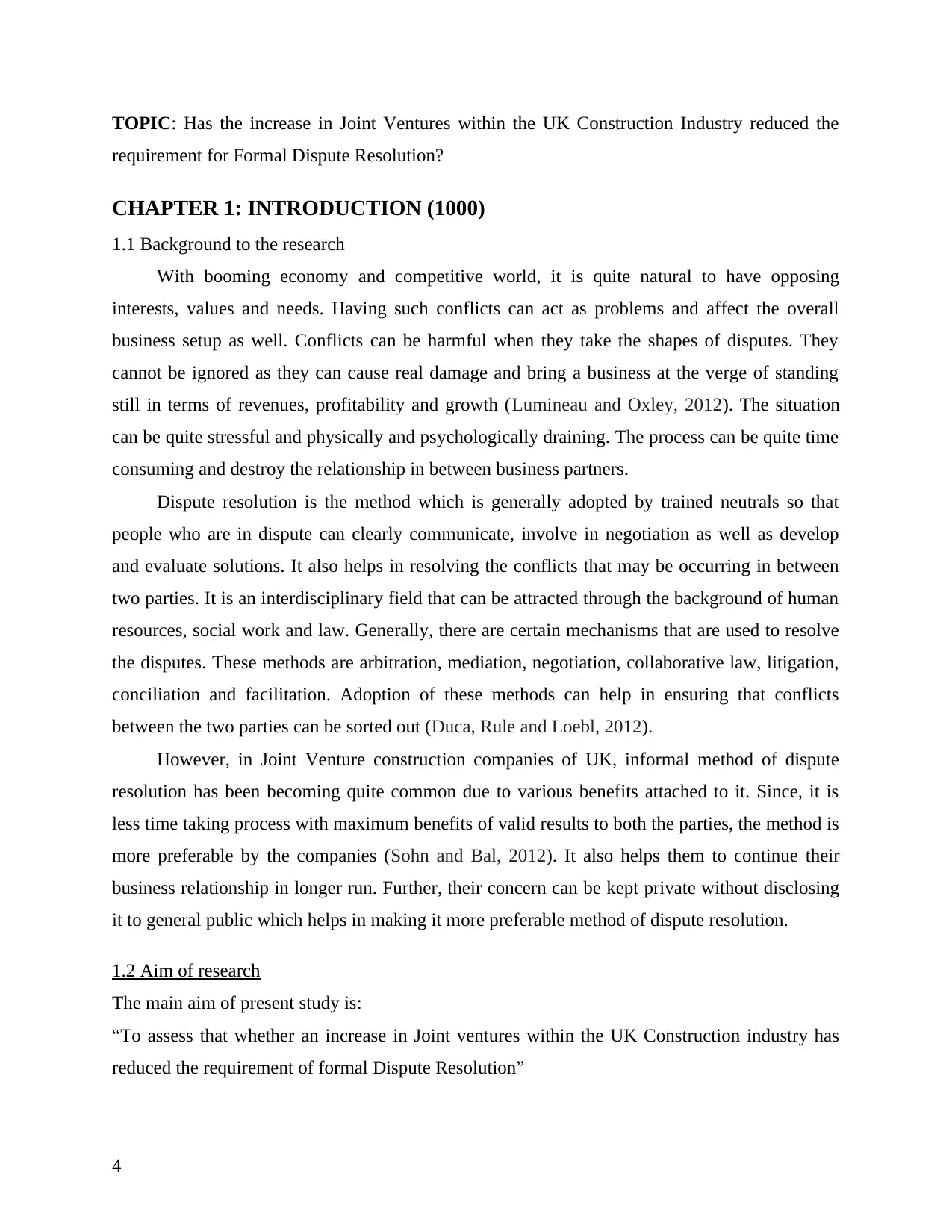
TOPIC: Has the increase in Joint Ventures within the UK Construction Industry reduced the
requirement for Formal Dispute Resolution?
CHAPTER 1: INTRODUCTION (1000)
1.1 Background to the research
With booming economy and competitive world, it is quite natural to have opposing
interests, values and needs. Having such conflicts can act as problems and affect the overall
business setup as well. Conflicts can be harmful when they take the shapes of disputes. They
cannot be ignored as they can cause real damage and bring a business at the verge of standing
still in terms of revenues, profitability and growth (Lumineau and Oxley, 2012). The situation
can be quite stressful and physically and psychologically draining. The process can be quite time
consuming and destroy the relationship in between business partners.
Dispute resolution is the method which is generally adopted by trained neutrals so that
people who are in dispute can clearly communicate, involve in negotiation as well as develop
and evaluate solutions. It also helps in resolving the conflicts that may be occurring in between
two parties. It is an interdisciplinary field that can be attracted through the background of human
resources, social work and law. Generally, there are certain mechanisms that are used to resolve
the disputes. These methods are arbitration, mediation, negotiation, collaborative law, litigation,
conciliation and facilitation. Adoption of these methods can help in ensuring that conflicts
between the two parties can be sorted out (Duca, Rule and Loebl, 2012).
However, in Joint Venture construction companies of UK, informal method of dispute
resolution has been becoming quite common due to various benefits attached to it. Since, it is
less time taking process with maximum benefits of valid results to both the parties, the method is
more preferable by the companies (Sohn and Bal, 2012). It also helps them to continue their
business relationship in longer run. Further, their concern can be kept private without disclosing
it to general public which helps in making it more preferable method of dispute resolution.
1.2 Aim of research
The main aim of present study is:
“To assess that whether an increase in Joint ventures within the UK Construction industry has
reduced the requirement of formal Dispute Resolution”
4
requirement for Formal Dispute Resolution?
CHAPTER 1: INTRODUCTION (1000)
1.1 Background to the research
With booming economy and competitive world, it is quite natural to have opposing
interests, values and needs. Having such conflicts can act as problems and affect the overall
business setup as well. Conflicts can be harmful when they take the shapes of disputes. They
cannot be ignored as they can cause real damage and bring a business at the verge of standing
still in terms of revenues, profitability and growth (Lumineau and Oxley, 2012). The situation
can be quite stressful and physically and psychologically draining. The process can be quite time
consuming and destroy the relationship in between business partners.
Dispute resolution is the method which is generally adopted by trained neutrals so that
people who are in dispute can clearly communicate, involve in negotiation as well as develop
and evaluate solutions. It also helps in resolving the conflicts that may be occurring in between
two parties. It is an interdisciplinary field that can be attracted through the background of human
resources, social work and law. Generally, there are certain mechanisms that are used to resolve
the disputes. These methods are arbitration, mediation, negotiation, collaborative law, litigation,
conciliation and facilitation. Adoption of these methods can help in ensuring that conflicts
between the two parties can be sorted out (Duca, Rule and Loebl, 2012).
However, in Joint Venture construction companies of UK, informal method of dispute
resolution has been becoming quite common due to various benefits attached to it. Since, it is
less time taking process with maximum benefits of valid results to both the parties, the method is
more preferable by the companies (Sohn and Bal, 2012). It also helps them to continue their
business relationship in longer run. Further, their concern can be kept private without disclosing
it to general public which helps in making it more preferable method of dispute resolution.
1.2 Aim of research
The main aim of present study is:
“To assess that whether an increase in Joint ventures within the UK Construction industry has
reduced the requirement of formal Dispute Resolution”
4
Paraphrase This Document
Need a fresh take? Get an instant paraphrase of this document with our AI Paraphraser
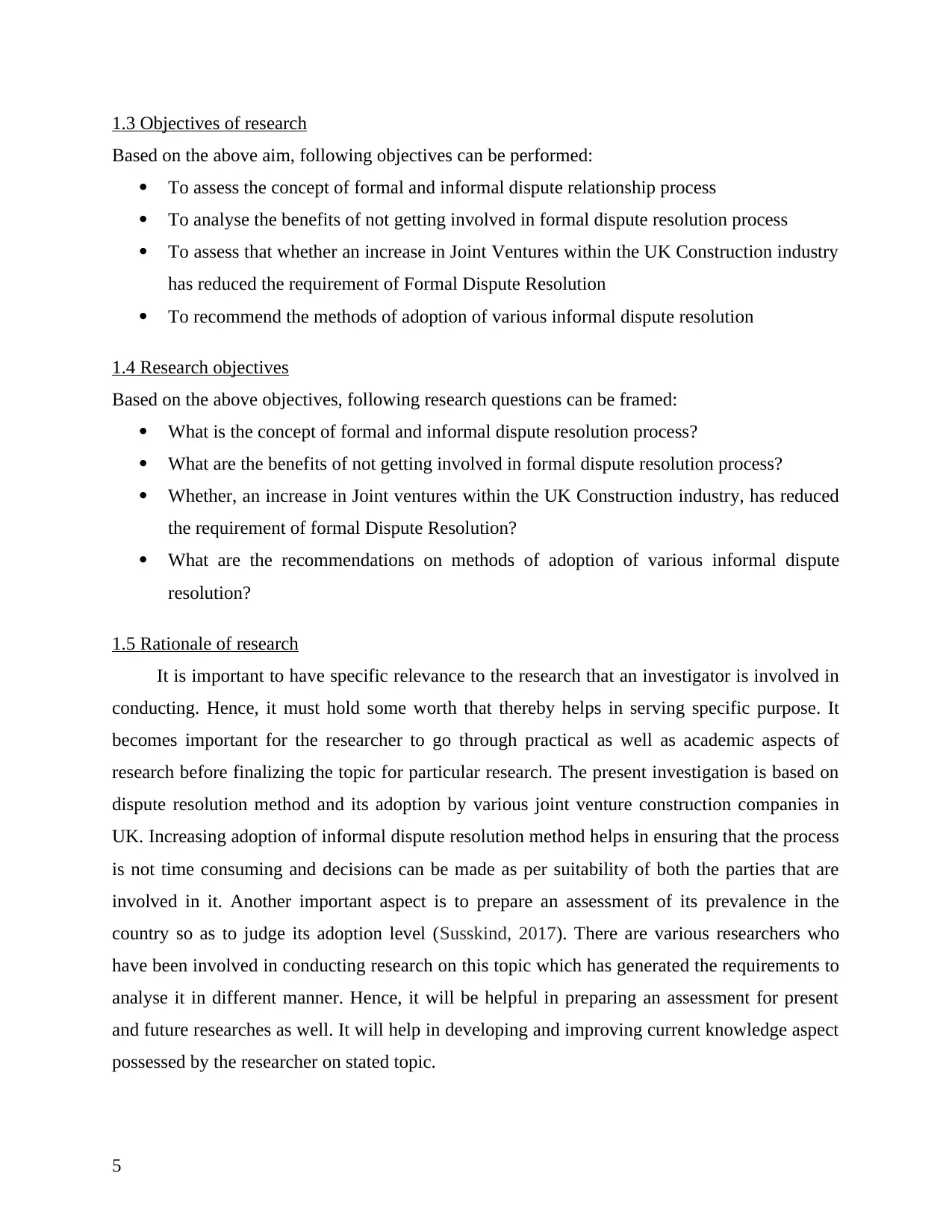
1.3 Objectives of research
Based on the above aim, following objectives can be performed:
To assess the concept of formal and informal dispute relationship process
To analyse the benefits of not getting involved in formal dispute resolution process
To assess that whether an increase in Joint Ventures within the UK Construction industry
has reduced the requirement of Formal Dispute Resolution
To recommend the methods of adoption of various informal dispute resolution
1.4 Research objectives
Based on the above objectives, following research questions can be framed:
What is the concept of formal and informal dispute resolution process?
What are the benefits of not getting involved in formal dispute resolution process?
Whether, an increase in Joint ventures within the UK Construction industry, has reduced
the requirement of formal Dispute Resolution?
What are the recommendations on methods of adoption of various informal dispute
resolution?
1.5 Rationale of research
It is important to have specific relevance to the research that an investigator is involved in
conducting. Hence, it must hold some worth that thereby helps in serving specific purpose. It
becomes important for the researcher to go through practical as well as academic aspects of
research before finalizing the topic for particular research. The present investigation is based on
dispute resolution method and its adoption by various joint venture construction companies in
UK. Increasing adoption of informal dispute resolution method helps in ensuring that the process
is not time consuming and decisions can be made as per suitability of both the parties that are
involved in it. Another important aspect is to prepare an assessment of its prevalence in the
country so as to judge its adoption level (Susskind, 2017). There are various researchers who
have been involved in conducting research on this topic which has generated the requirements to
analyse it in different manner. Hence, it will be helpful in preparing an assessment for present
and future researches as well. It will help in developing and improving current knowledge aspect
possessed by the researcher on stated topic.
5
Based on the above aim, following objectives can be performed:
To assess the concept of formal and informal dispute relationship process
To analyse the benefits of not getting involved in formal dispute resolution process
To assess that whether an increase in Joint Ventures within the UK Construction industry
has reduced the requirement of Formal Dispute Resolution
To recommend the methods of adoption of various informal dispute resolution
1.4 Research objectives
Based on the above objectives, following research questions can be framed:
What is the concept of formal and informal dispute resolution process?
What are the benefits of not getting involved in formal dispute resolution process?
Whether, an increase in Joint ventures within the UK Construction industry, has reduced
the requirement of formal Dispute Resolution?
What are the recommendations on methods of adoption of various informal dispute
resolution?
1.5 Rationale of research
It is important to have specific relevance to the research that an investigator is involved in
conducting. Hence, it must hold some worth that thereby helps in serving specific purpose. It
becomes important for the researcher to go through practical as well as academic aspects of
research before finalizing the topic for particular research. The present investigation is based on
dispute resolution method and its adoption by various joint venture construction companies in
UK. Increasing adoption of informal dispute resolution method helps in ensuring that the process
is not time consuming and decisions can be made as per suitability of both the parties that are
involved in it. Another important aspect is to prepare an assessment of its prevalence in the
country so as to judge its adoption level (Susskind, 2017). There are various researchers who
have been involved in conducting research on this topic which has generated the requirements to
analyse it in different manner. Hence, it will be helpful in preparing an assessment for present
and future researches as well. It will help in developing and improving current knowledge aspect
possessed by the researcher on stated topic.
5
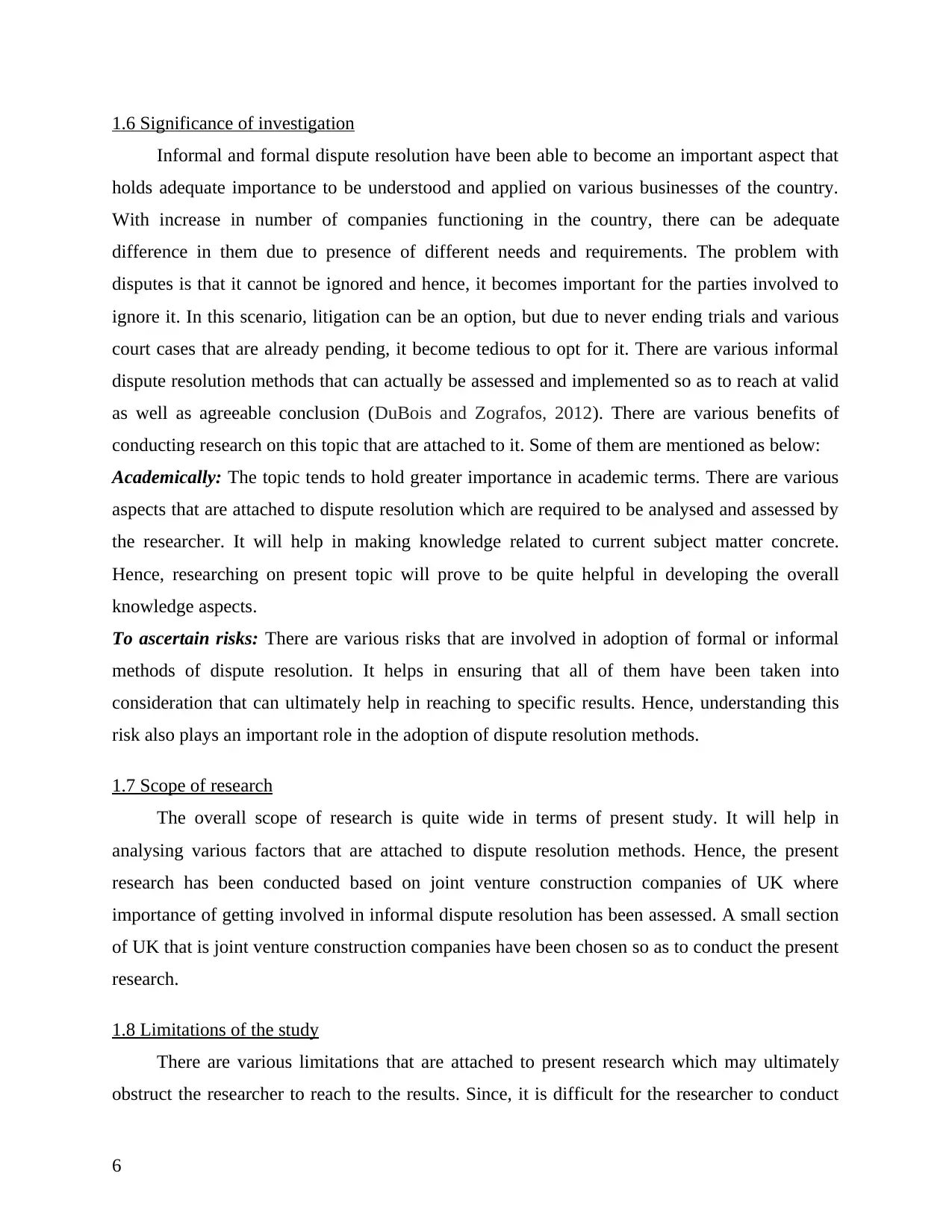
1.6 Significance of investigation
Informal and formal dispute resolution have been able to become an important aspect that
holds adequate importance to be understood and applied on various businesses of the country.
With increase in number of companies functioning in the country, there can be adequate
difference in them due to presence of different needs and requirements. The problem with
disputes is that it cannot be ignored and hence, it becomes important for the parties involved to
ignore it. In this scenario, litigation can be an option, but due to never ending trials and various
court cases that are already pending, it become tedious to opt for it. There are various informal
dispute resolution methods that can actually be assessed and implemented so as to reach at valid
as well as agreeable conclusion (DuBois and Zografos, 2012). There are various benefits of
conducting research on this topic that are attached to it. Some of them are mentioned as below:
Academically: The topic tends to hold greater importance in academic terms. There are various
aspects that are attached to dispute resolution which are required to be analysed and assessed by
the researcher. It will help in making knowledge related to current subject matter concrete.
Hence, researching on present topic will prove to be quite helpful in developing the overall
knowledge aspects.
To ascertain risks: There are various risks that are involved in adoption of formal or informal
methods of dispute resolution. It helps in ensuring that all of them have been taken into
consideration that can ultimately help in reaching to specific results. Hence, understanding this
risk also plays an important role in the adoption of dispute resolution methods.
1.7 Scope of research
The overall scope of research is quite wide in terms of present study. It will help in
analysing various factors that are attached to dispute resolution methods. Hence, the present
research has been conducted based on joint venture construction companies of UK where
importance of getting involved in informal dispute resolution has been assessed. A small section
of UK that is joint venture construction companies have been chosen so as to conduct the present
research.
1.8 Limitations of the study
There are various limitations that are attached to present research which may ultimately
obstruct the researcher to reach to the results. Since, it is difficult for the researcher to conduct
6
Informal and formal dispute resolution have been able to become an important aspect that
holds adequate importance to be understood and applied on various businesses of the country.
With increase in number of companies functioning in the country, there can be adequate
difference in them due to presence of different needs and requirements. The problem with
disputes is that it cannot be ignored and hence, it becomes important for the parties involved to
ignore it. In this scenario, litigation can be an option, but due to never ending trials and various
court cases that are already pending, it become tedious to opt for it. There are various informal
dispute resolution methods that can actually be assessed and implemented so as to reach at valid
as well as agreeable conclusion (DuBois and Zografos, 2012). There are various benefits of
conducting research on this topic that are attached to it. Some of them are mentioned as below:
Academically: The topic tends to hold greater importance in academic terms. There are various
aspects that are attached to dispute resolution which are required to be analysed and assessed by
the researcher. It will help in making knowledge related to current subject matter concrete.
Hence, researching on present topic will prove to be quite helpful in developing the overall
knowledge aspects.
To ascertain risks: There are various risks that are involved in adoption of formal or informal
methods of dispute resolution. It helps in ensuring that all of them have been taken into
consideration that can ultimately help in reaching to specific results. Hence, understanding this
risk also plays an important role in the adoption of dispute resolution methods.
1.7 Scope of research
The overall scope of research is quite wide in terms of present study. It will help in
analysing various factors that are attached to dispute resolution methods. Hence, the present
research has been conducted based on joint venture construction companies of UK where
importance of getting involved in informal dispute resolution has been assessed. A small section
of UK that is joint venture construction companies have been chosen so as to conduct the present
research.
1.8 Limitations of the study
There are various limitations that are attached to present research which may ultimately
obstruct the researcher to reach to the results. Since, it is difficult for the researcher to conduct
6
⊘ This is a preview!⊘
Do you want full access?
Subscribe today to unlock all pages.

Trusted by 1+ million students worldwide
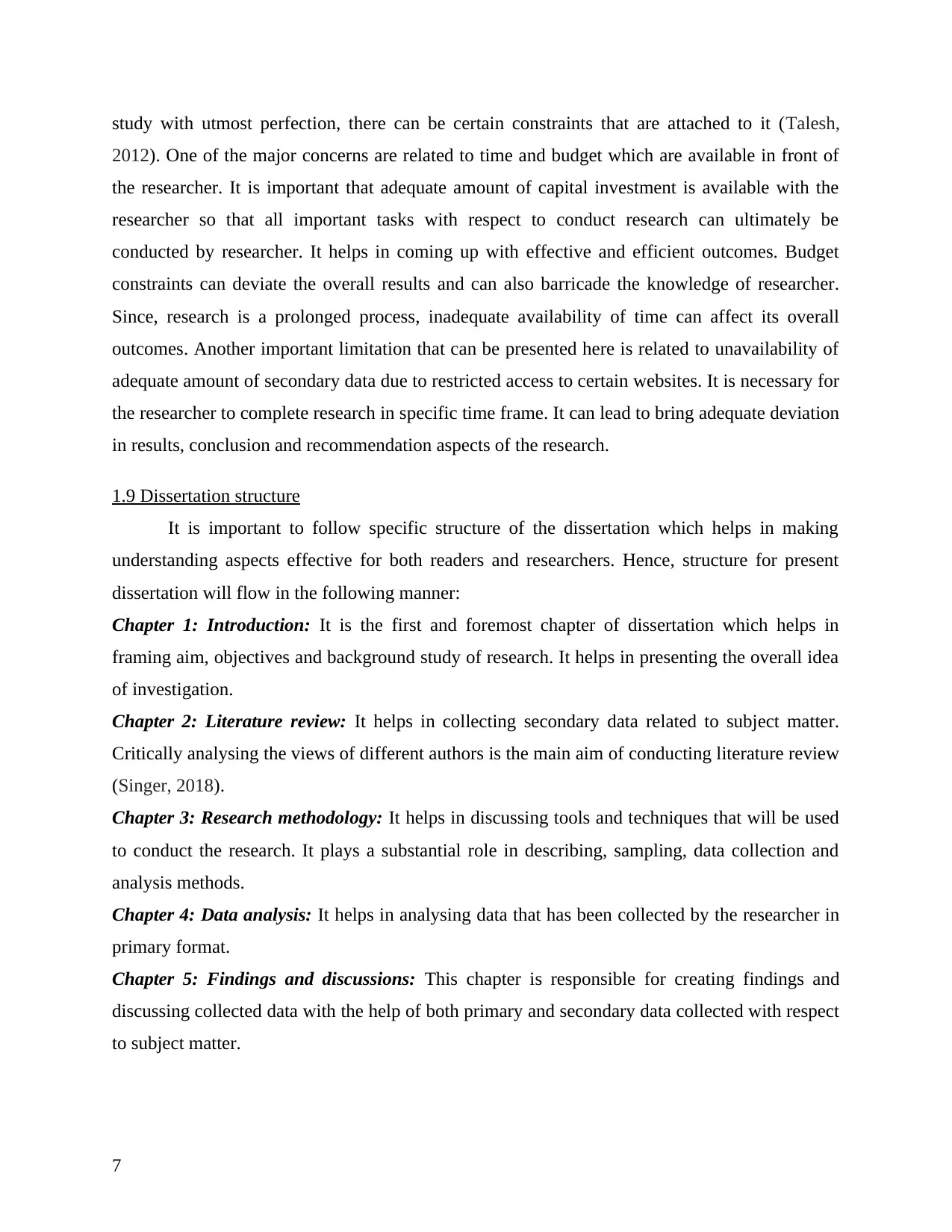
study with utmost perfection, there can be certain constraints that are attached to it (Talesh,
2012). One of the major concerns are related to time and budget which are available in front of
the researcher. It is important that adequate amount of capital investment is available with the
researcher so that all important tasks with respect to conduct research can ultimately be
conducted by researcher. It helps in coming up with effective and efficient outcomes. Budget
constraints can deviate the overall results and can also barricade the knowledge of researcher.
Since, research is a prolonged process, inadequate availability of time can affect its overall
outcomes. Another important limitation that can be presented here is related to unavailability of
adequate amount of secondary data due to restricted access to certain websites. It is necessary for
the researcher to complete research in specific time frame. It can lead to bring adequate deviation
in results, conclusion and recommendation aspects of the research.
1.9 Dissertation structure
It is important to follow specific structure of the dissertation which helps in making
understanding aspects effective for both readers and researchers. Hence, structure for present
dissertation will flow in the following manner:
Chapter 1: Introduction: It is the first and foremost chapter of dissertation which helps in
framing aim, objectives and background study of research. It helps in presenting the overall idea
of investigation.
Chapter 2: Literature review: It helps in collecting secondary data related to subject matter.
Critically analysing the views of different authors is the main aim of conducting literature review
(Singer, 2018).
Chapter 3: Research methodology: It helps in discussing tools and techniques that will be used
to conduct the research. It plays a substantial role in describing, sampling, data collection and
analysis methods.
Chapter 4: Data analysis: It helps in analysing data that has been collected by the researcher in
primary format.
Chapter 5: Findings and discussions: This chapter is responsible for creating findings and
discussing collected data with the help of both primary and secondary data collected with respect
to subject matter.
7
2012). One of the major concerns are related to time and budget which are available in front of
the researcher. It is important that adequate amount of capital investment is available with the
researcher so that all important tasks with respect to conduct research can ultimately be
conducted by researcher. It helps in coming up with effective and efficient outcomes. Budget
constraints can deviate the overall results and can also barricade the knowledge of researcher.
Since, research is a prolonged process, inadequate availability of time can affect its overall
outcomes. Another important limitation that can be presented here is related to unavailability of
adequate amount of secondary data due to restricted access to certain websites. It is necessary for
the researcher to complete research in specific time frame. It can lead to bring adequate deviation
in results, conclusion and recommendation aspects of the research.
1.9 Dissertation structure
It is important to follow specific structure of the dissertation which helps in making
understanding aspects effective for both readers and researchers. Hence, structure for present
dissertation will flow in the following manner:
Chapter 1: Introduction: It is the first and foremost chapter of dissertation which helps in
framing aim, objectives and background study of research. It helps in presenting the overall idea
of investigation.
Chapter 2: Literature review: It helps in collecting secondary data related to subject matter.
Critically analysing the views of different authors is the main aim of conducting literature review
(Singer, 2018).
Chapter 3: Research methodology: It helps in discussing tools and techniques that will be used
to conduct the research. It plays a substantial role in describing, sampling, data collection and
analysis methods.
Chapter 4: Data analysis: It helps in analysing data that has been collected by the researcher in
primary format.
Chapter 5: Findings and discussions: This chapter is responsible for creating findings and
discussing collected data with the help of both primary and secondary data collected with respect
to subject matter.
7
Paraphrase This Document
Need a fresh take? Get an instant paraphrase of this document with our AI Paraphraser
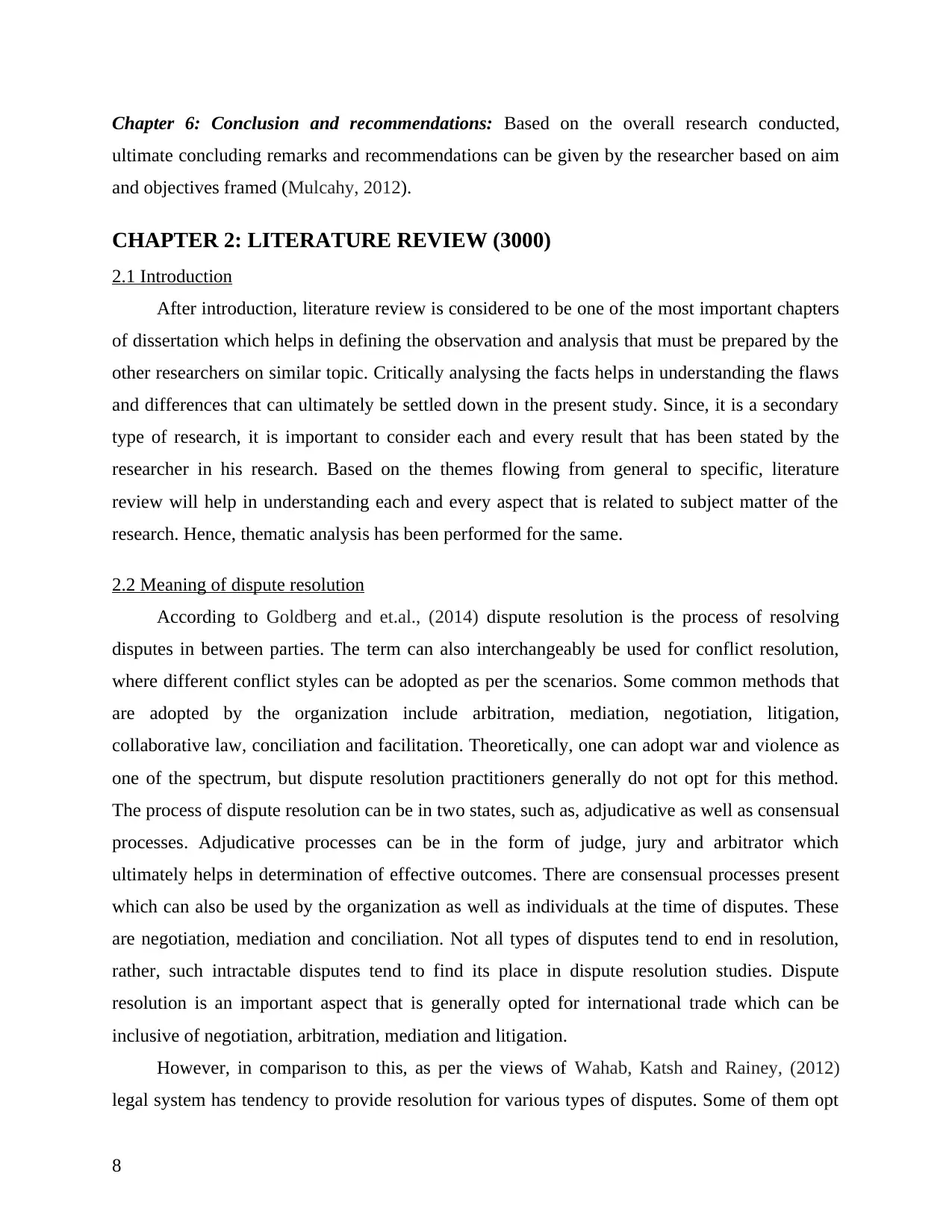
Chapter 6: Conclusion and recommendations: Based on the overall research conducted,
ultimate concluding remarks and recommendations can be given by the researcher based on aim
and objectives framed (Mulcahy, 2012).
CHAPTER 2: LITERATURE REVIEW (3000)
2.1 Introduction
After introduction, literature review is considered to be one of the most important chapters
of dissertation which helps in defining the observation and analysis that must be prepared by the
other researchers on similar topic. Critically analysing the facts helps in understanding the flaws
and differences that can ultimately be settled down in the present study. Since, it is a secondary
type of research, it is important to consider each and every result that has been stated by the
researcher in his research. Based on the themes flowing from general to specific, literature
review will help in understanding each and every aspect that is related to subject matter of the
research. Hence, thematic analysis has been performed for the same.
2.2 Meaning of dispute resolution
According to Goldberg and et.al., (2014) dispute resolution is the process of resolving
disputes in between parties. The term can also interchangeably be used for conflict resolution,
where different conflict styles can be adopted as per the scenarios. Some common methods that
are adopted by the organization include arbitration, mediation, negotiation, litigation,
collaborative law, conciliation and facilitation. Theoretically, one can adopt war and violence as
one of the spectrum, but dispute resolution practitioners generally do not opt for this method.
The process of dispute resolution can be in two states, such as, adjudicative as well as consensual
processes. Adjudicative processes can be in the form of judge, jury and arbitrator which
ultimately helps in determination of effective outcomes. There are consensual processes present
which can also be used by the organization as well as individuals at the time of disputes. These
are negotiation, mediation and conciliation. Not all types of disputes tend to end in resolution,
rather, such intractable disputes tend to find its place in dispute resolution studies. Dispute
resolution is an important aspect that is generally opted for international trade which can be
inclusive of negotiation, arbitration, mediation and litigation.
However, in comparison to this, as per the views of Wahab, Katsh and Rainey, (2012)
legal system has tendency to provide resolution for various types of disputes. Some of them opt
8
ultimate concluding remarks and recommendations can be given by the researcher based on aim
and objectives framed (Mulcahy, 2012).
CHAPTER 2: LITERATURE REVIEW (3000)
2.1 Introduction
After introduction, literature review is considered to be one of the most important chapters
of dissertation which helps in defining the observation and analysis that must be prepared by the
other researchers on similar topic. Critically analysing the facts helps in understanding the flaws
and differences that can ultimately be settled down in the present study. Since, it is a secondary
type of research, it is important to consider each and every result that has been stated by the
researcher in his research. Based on the themes flowing from general to specific, literature
review will help in understanding each and every aspect that is related to subject matter of the
research. Hence, thematic analysis has been performed for the same.
2.2 Meaning of dispute resolution
According to Goldberg and et.al., (2014) dispute resolution is the process of resolving
disputes in between parties. The term can also interchangeably be used for conflict resolution,
where different conflict styles can be adopted as per the scenarios. Some common methods that
are adopted by the organization include arbitration, mediation, negotiation, litigation,
collaborative law, conciliation and facilitation. Theoretically, one can adopt war and violence as
one of the spectrum, but dispute resolution practitioners generally do not opt for this method.
The process of dispute resolution can be in two states, such as, adjudicative as well as consensual
processes. Adjudicative processes can be in the form of judge, jury and arbitrator which
ultimately helps in determination of effective outcomes. There are consensual processes present
which can also be used by the organization as well as individuals at the time of disputes. These
are negotiation, mediation and conciliation. Not all types of disputes tend to end in resolution,
rather, such intractable disputes tend to find its place in dispute resolution studies. Dispute
resolution is an important aspect that is generally opted for international trade which can be
inclusive of negotiation, arbitration, mediation and litigation.
However, in comparison to this, as per the views of Wahab, Katsh and Rainey, (2012)
legal system has tendency to provide resolution for various types of disputes. Some of them opt
8
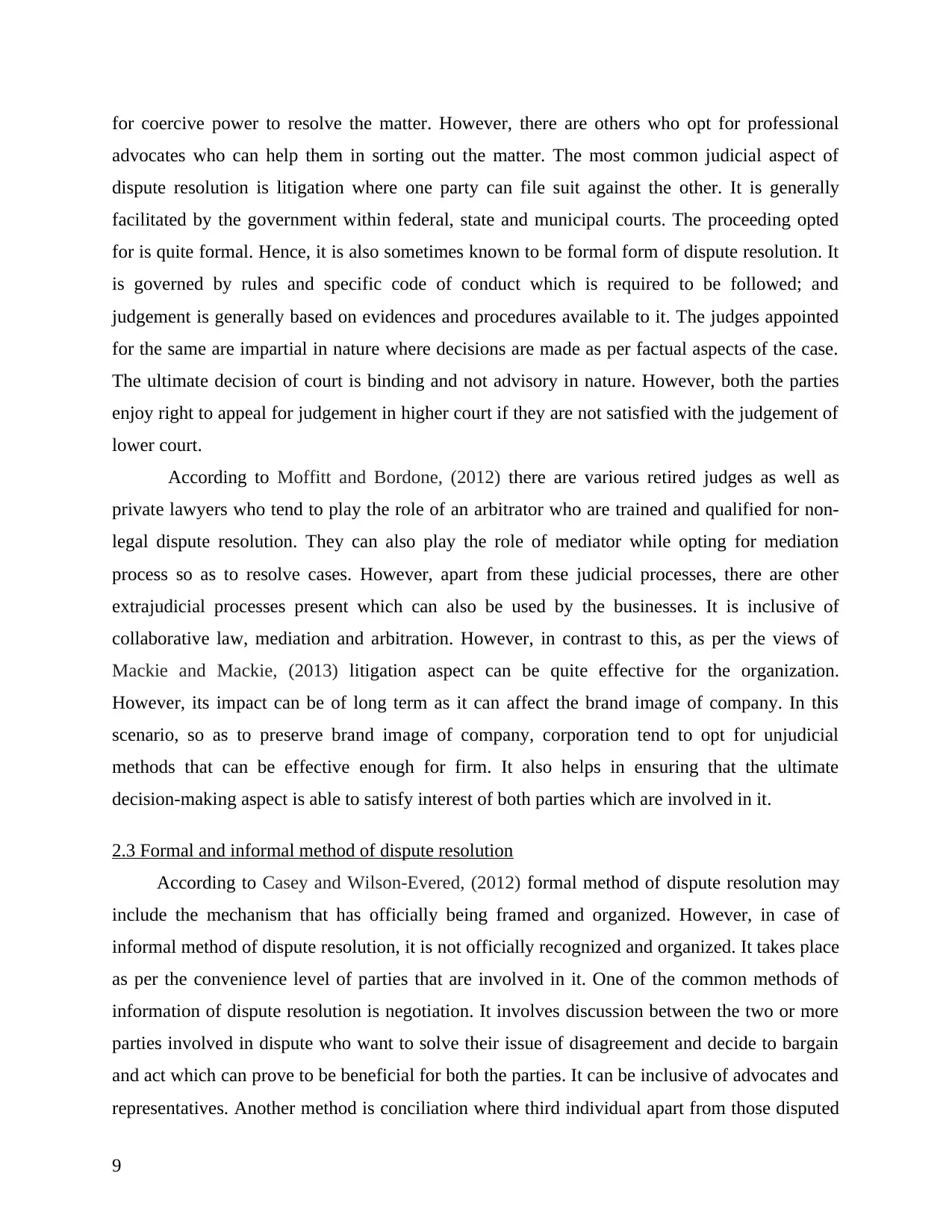
for coercive power to resolve the matter. However, there are others who opt for professional
advocates who can help them in sorting out the matter. The most common judicial aspect of
dispute resolution is litigation where one party can file suit against the other. It is generally
facilitated by the government within federal, state and municipal courts. The proceeding opted
for is quite formal. Hence, it is also sometimes known to be formal form of dispute resolution. It
is governed by rules and specific code of conduct which is required to be followed; and
judgement is generally based on evidences and procedures available to it. The judges appointed
for the same are impartial in nature where decisions are made as per factual aspects of the case.
The ultimate decision of court is binding and not advisory in nature. However, both the parties
enjoy right to appeal for judgement in higher court if they are not satisfied with the judgement of
lower court.
According to Moffitt and Bordone, (2012) there are various retired judges as well as
private lawyers who tend to play the role of an arbitrator who are trained and qualified for non-
legal dispute resolution. They can also play the role of mediator while opting for mediation
process so as to resolve cases. However, apart from these judicial processes, there are other
extrajudicial processes present which can also be used by the businesses. It is inclusive of
collaborative law, mediation and arbitration. However, in contrast to this, as per the views of
Mackie and Mackie, (2013) litigation aspect can be quite effective for the organization.
However, its impact can be of long term as it can affect the brand image of company. In this
scenario, so as to preserve brand image of company, corporation tend to opt for unjudicial
methods that can be effective enough for firm. It also helps in ensuring that the ultimate
decision-making aspect is able to satisfy interest of both parties which are involved in it.
2.3 Formal and informal method of dispute resolution
According to Casey and Wilson-Evered, (2012) formal method of dispute resolution may
include the mechanism that has officially being framed and organized. However, in case of
informal method of dispute resolution, it is not officially recognized and organized. It takes place
as per the convenience level of parties that are involved in it. One of the common methods of
information of dispute resolution is negotiation. It involves discussion between the two or more
parties involved in dispute who want to solve their issue of disagreement and decide to bargain
and act which can prove to be beneficial for both the parties. It can be inclusive of advocates and
representatives. Another method is conciliation where third individual apart from those disputed
9
advocates who can help them in sorting out the matter. The most common judicial aspect of
dispute resolution is litigation where one party can file suit against the other. It is generally
facilitated by the government within federal, state and municipal courts. The proceeding opted
for is quite formal. Hence, it is also sometimes known to be formal form of dispute resolution. It
is governed by rules and specific code of conduct which is required to be followed; and
judgement is generally based on evidences and procedures available to it. The judges appointed
for the same are impartial in nature where decisions are made as per factual aspects of the case.
The ultimate decision of court is binding and not advisory in nature. However, both the parties
enjoy right to appeal for judgement in higher court if they are not satisfied with the judgement of
lower court.
According to Moffitt and Bordone, (2012) there are various retired judges as well as
private lawyers who tend to play the role of an arbitrator who are trained and qualified for non-
legal dispute resolution. They can also play the role of mediator while opting for mediation
process so as to resolve cases. However, apart from these judicial processes, there are other
extrajudicial processes present which can also be used by the businesses. It is inclusive of
collaborative law, mediation and arbitration. However, in contrast to this, as per the views of
Mackie and Mackie, (2013) litigation aspect can be quite effective for the organization.
However, its impact can be of long term as it can affect the brand image of company. In this
scenario, so as to preserve brand image of company, corporation tend to opt for unjudicial
methods that can be effective enough for firm. It also helps in ensuring that the ultimate
decision-making aspect is able to satisfy interest of both parties which are involved in it.
2.3 Formal and informal method of dispute resolution
According to Casey and Wilson-Evered, (2012) formal method of dispute resolution may
include the mechanism that has officially being framed and organized. However, in case of
informal method of dispute resolution, it is not officially recognized and organized. It takes place
as per the convenience level of parties that are involved in it. One of the common methods of
information of dispute resolution is negotiation. It involves discussion between the two or more
parties involved in dispute who want to solve their issue of disagreement and decide to bargain
and act which can prove to be beneficial for both the parties. It can be inclusive of advocates and
representatives. Another method is conciliation where third individual apart from those disputed
9
⊘ This is a preview!⊘
Do you want full access?
Subscribe today to unlock all pages.

Trusted by 1+ million students worldwide
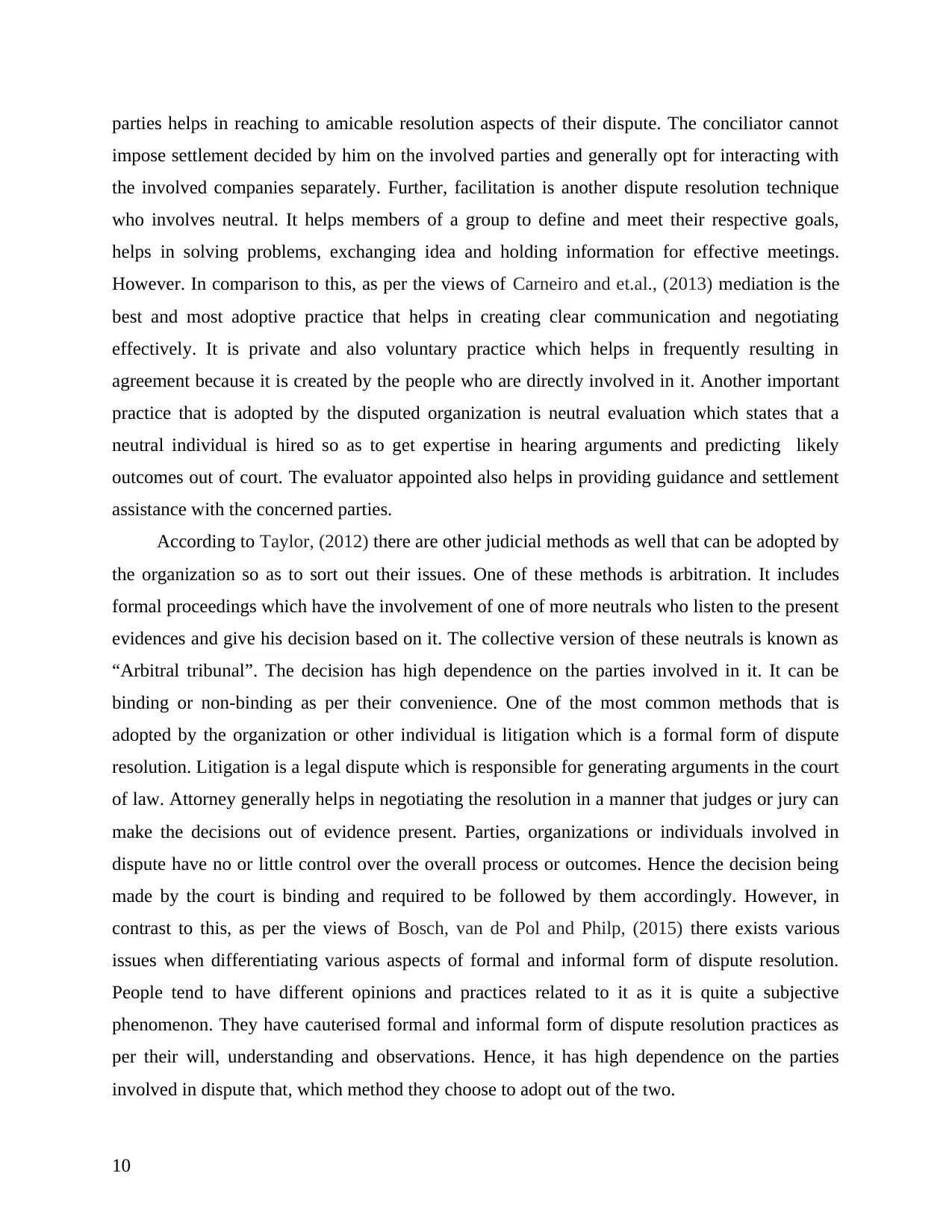
parties helps in reaching to amicable resolution aspects of their dispute. The conciliator cannot
impose settlement decided by him on the involved parties and generally opt for interacting with
the involved companies separately. Further, facilitation is another dispute resolution technique
who involves neutral. It helps members of a group to define and meet their respective goals,
helps in solving problems, exchanging idea and holding information for effective meetings.
However. In comparison to this, as per the views of Carneiro and et.al., (2013) mediation is the
best and most adoptive practice that helps in creating clear communication and negotiating
effectively. It is private and also voluntary practice which helps in frequently resulting in
agreement because it is created by the people who are directly involved in it. Another important
practice that is adopted by the disputed organization is neutral evaluation which states that a
neutral individual is hired so as to get expertise in hearing arguments and predicting likely
outcomes out of court. The evaluator appointed also helps in providing guidance and settlement
assistance with the concerned parties.
According to Taylor, (2012) there are other judicial methods as well that can be adopted by
the organization so as to sort out their issues. One of these methods is arbitration. It includes
formal proceedings which have the involvement of one of more neutrals who listen to the present
evidences and give his decision based on it. The collective version of these neutrals is known as
“Arbitral tribunal”. The decision has high dependence on the parties involved in it. It can be
binding or non-binding as per their convenience. One of the most common methods that is
adopted by the organization or other individual is litigation which is a formal form of dispute
resolution. Litigation is a legal dispute which is responsible for generating arguments in the court
of law. Attorney generally helps in negotiating the resolution in a manner that judges or jury can
make the decisions out of evidence present. Parties, organizations or individuals involved in
dispute have no or little control over the overall process or outcomes. Hence the decision being
made by the court is binding and required to be followed by them accordingly. However, in
contrast to this, as per the views of Bosch, van de Pol and Philp, (2015) there exists various
issues when differentiating various aspects of formal and informal form of dispute resolution.
People tend to have different opinions and practices related to it as it is quite a subjective
phenomenon. They have cauterised formal and informal form of dispute resolution practices as
per their will, understanding and observations. Hence, it has high dependence on the parties
involved in dispute that, which method they choose to adopt out of the two.
10
impose settlement decided by him on the involved parties and generally opt for interacting with
the involved companies separately. Further, facilitation is another dispute resolution technique
who involves neutral. It helps members of a group to define and meet their respective goals,
helps in solving problems, exchanging idea and holding information for effective meetings.
However. In comparison to this, as per the views of Carneiro and et.al., (2013) mediation is the
best and most adoptive practice that helps in creating clear communication and negotiating
effectively. It is private and also voluntary practice which helps in frequently resulting in
agreement because it is created by the people who are directly involved in it. Another important
practice that is adopted by the disputed organization is neutral evaluation which states that a
neutral individual is hired so as to get expertise in hearing arguments and predicting likely
outcomes out of court. The evaluator appointed also helps in providing guidance and settlement
assistance with the concerned parties.
According to Taylor, (2012) there are other judicial methods as well that can be adopted by
the organization so as to sort out their issues. One of these methods is arbitration. It includes
formal proceedings which have the involvement of one of more neutrals who listen to the present
evidences and give his decision based on it. The collective version of these neutrals is known as
“Arbitral tribunal”. The decision has high dependence on the parties involved in it. It can be
binding or non-binding as per their convenience. One of the most common methods that is
adopted by the organization or other individual is litigation which is a formal form of dispute
resolution. Litigation is a legal dispute which is responsible for generating arguments in the court
of law. Attorney generally helps in negotiating the resolution in a manner that judges or jury can
make the decisions out of evidence present. Parties, organizations or individuals involved in
dispute have no or little control over the overall process or outcomes. Hence the decision being
made by the court is binding and required to be followed by them accordingly. However, in
contrast to this, as per the views of Bosch, van de Pol and Philp, (2015) there exists various
issues when differentiating various aspects of formal and informal form of dispute resolution.
People tend to have different opinions and practices related to it as it is quite a subjective
phenomenon. They have cauterised formal and informal form of dispute resolution practices as
per their will, understanding and observations. Hence, it has high dependence on the parties
involved in dispute that, which method they choose to adopt out of the two.
10
Paraphrase This Document
Need a fresh take? Get an instant paraphrase of this document with our AI Paraphraser
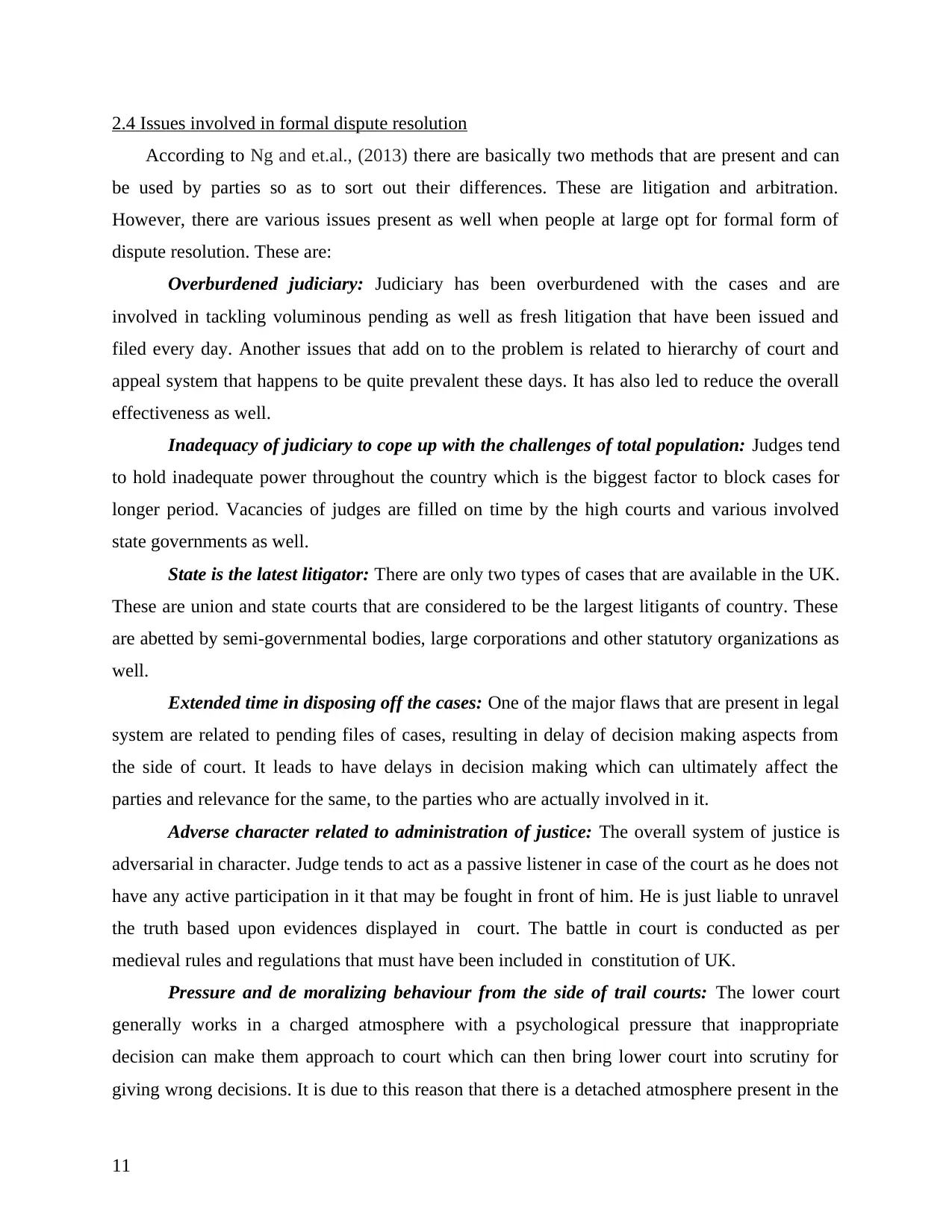
2.4 Issues involved in formal dispute resolution
According to Ng and et.al., (2013) there are basically two methods that are present and can
be used by parties so as to sort out their differences. These are litigation and arbitration.
However, there are various issues present as well when people at large opt for formal form of
dispute resolution. These are:
Overburdened judiciary: Judiciary has been overburdened with the cases and are
involved in tackling voluminous pending as well as fresh litigation that have been issued and
filed every day. Another issues that add on to the problem is related to hierarchy of court and
appeal system that happens to be quite prevalent these days. It has also led to reduce the overall
effectiveness as well.
Inadequacy of judiciary to cope up with the challenges of total population: Judges tend
to hold inadequate power throughout the country which is the biggest factor to block cases for
longer period. Vacancies of judges are filled on time by the high courts and various involved
state governments as well.
State is the latest litigator: There are only two types of cases that are available in the UK.
These are union and state courts that are considered to be the largest litigants of country. These
are abetted by semi-governmental bodies, large corporations and other statutory organizations as
well.
Extended time in disposing off the cases: One of the major flaws that are present in legal
system are related to pending files of cases, resulting in delay of decision making aspects from
the side of court. It leads to have delays in decision making which can ultimately affect the
parties and relevance for the same, to the parties who are actually involved in it.
Adverse character related to administration of justice: The overall system of justice is
adversarial in character. Judge tends to act as a passive listener in case of the court as he does not
have any active participation in it that may be fought in front of him. He is just liable to unravel
the truth based upon evidences displayed in court. The battle in court is conducted as per
medieval rules and regulations that must have been included in constitution of UK.
Pressure and de moralizing behaviour from the side of trail courts: The lower court
generally works in a charged atmosphere with a psychological pressure that inappropriate
decision can make them approach to court which can then bring lower court into scrutiny for
giving wrong decisions. It is due to this reason that there is a detached atmosphere present in the
11
According to Ng and et.al., (2013) there are basically two methods that are present and can
be used by parties so as to sort out their differences. These are litigation and arbitration.
However, there are various issues present as well when people at large opt for formal form of
dispute resolution. These are:
Overburdened judiciary: Judiciary has been overburdened with the cases and are
involved in tackling voluminous pending as well as fresh litigation that have been issued and
filed every day. Another issues that add on to the problem is related to hierarchy of court and
appeal system that happens to be quite prevalent these days. It has also led to reduce the overall
effectiveness as well.
Inadequacy of judiciary to cope up with the challenges of total population: Judges tend
to hold inadequate power throughout the country which is the biggest factor to block cases for
longer period. Vacancies of judges are filled on time by the high courts and various involved
state governments as well.
State is the latest litigator: There are only two types of cases that are available in the UK.
These are union and state courts that are considered to be the largest litigants of country. These
are abetted by semi-governmental bodies, large corporations and other statutory organizations as
well.
Extended time in disposing off the cases: One of the major flaws that are present in legal
system are related to pending files of cases, resulting in delay of decision making aspects from
the side of court. It leads to have delays in decision making which can ultimately affect the
parties and relevance for the same, to the parties who are actually involved in it.
Adverse character related to administration of justice: The overall system of justice is
adversarial in character. Judge tends to act as a passive listener in case of the court as he does not
have any active participation in it that may be fought in front of him. He is just liable to unravel
the truth based upon evidences displayed in court. The battle in court is conducted as per
medieval rules and regulations that must have been included in constitution of UK.
Pressure and de moralizing behaviour from the side of trail courts: The lower court
generally works in a charged atmosphere with a psychological pressure that inappropriate
decision can make them approach to court which can then bring lower court into scrutiny for
giving wrong decisions. It is due to this reason that there is a detached atmosphere present in the
11
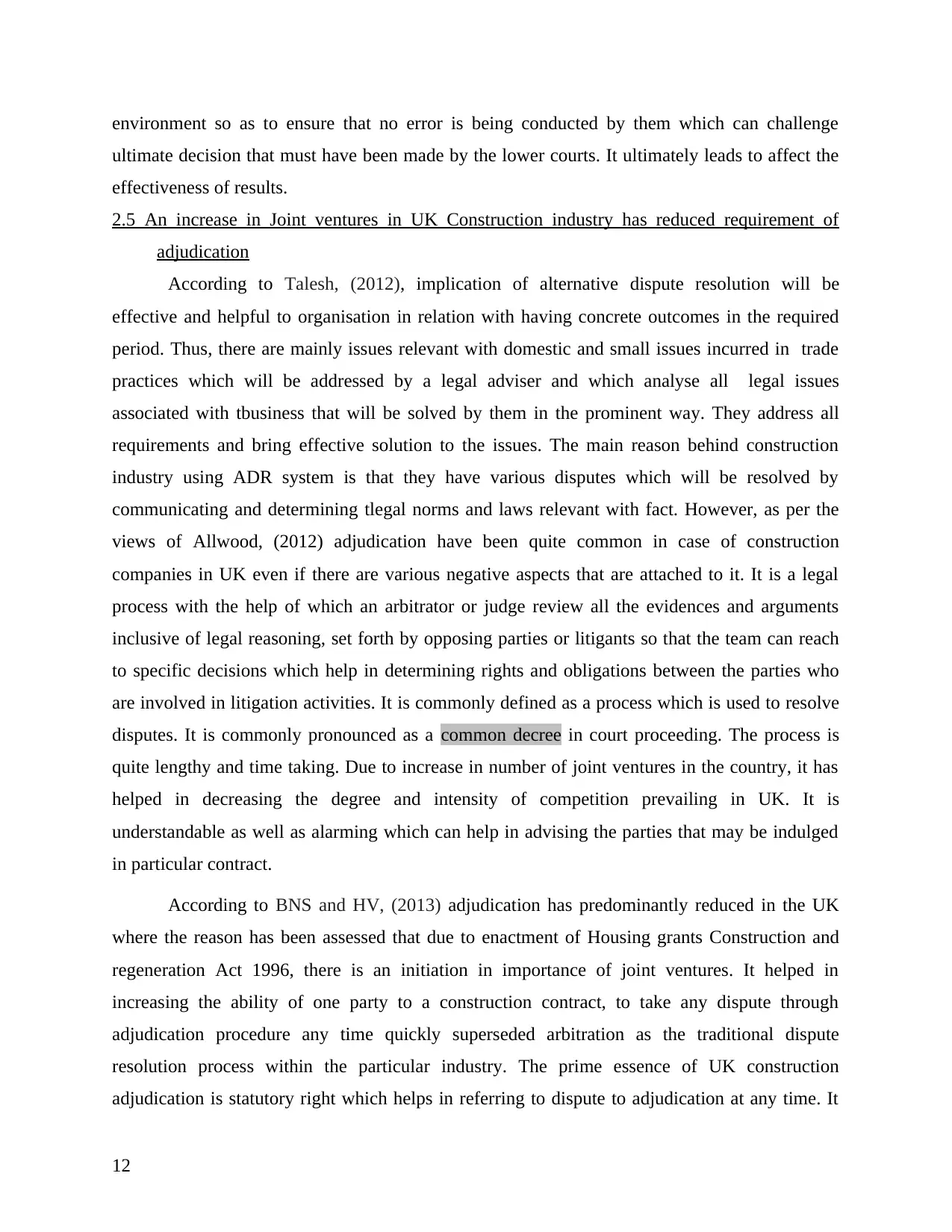
environment so as to ensure that no error is being conducted by them which can challenge
ultimate decision that must have been made by the lower courts. It ultimately leads to affect the
effectiveness of results.
2.5 An increase in Joint ventures in UK Construction industry has reduced requirement of
adjudication
According to Talesh, (2012), implication of alternative dispute resolution will be
effective and helpful to organisation in relation with having concrete outcomes in the required
period. Thus, there are mainly issues relevant with domestic and small issues incurred in trade
practices which will be addressed by a legal adviser and which analyse all legal issues
associated with tbusiness that will be solved by them in the prominent way. They address all
requirements and bring effective solution to the issues. The main reason behind construction
industry using ADR system is that they have various disputes which will be resolved by
communicating and determining tlegal norms and laws relevant with fact. However, as per the
views of Allwood, (2012) adjudication have been quite common in case of construction
companies in UK even if there are various negative aspects that are attached to it. It is a legal
process with the help of which an arbitrator or judge review all the evidences and arguments
inclusive of legal reasoning, set forth by opposing parties or litigants so that the team can reach
to specific decisions which help in determining rights and obligations between the parties who
are involved in litigation activities. It is commonly defined as a process which is used to resolve
disputes. It is commonly pronounced as a common decree in court proceeding. The process is
quite lengthy and time taking. Due to increase in number of joint ventures in the country, it has
helped in decreasing the degree and intensity of competition prevailing in UK. It is
understandable as well as alarming which can help in advising the parties that may be indulged
in particular contract.
According to BNS and HV, (2013) adjudication has predominantly reduced in the UK
where the reason has been assessed that due to enactment of Housing grants Construction and
regeneration Act 1996, there is an initiation in importance of joint ventures. It helped in
increasing the ability of one party to a construction contract, to take any dispute through
adjudication procedure any time quickly superseded arbitration as the traditional dispute
resolution process within the particular industry. The prime essence of UK construction
adjudication is statutory right which helps in referring to dispute to adjudication at any time. It
12
ultimate decision that must have been made by the lower courts. It ultimately leads to affect the
effectiveness of results.
2.5 An increase in Joint ventures in UK Construction industry has reduced requirement of
adjudication
According to Talesh, (2012), implication of alternative dispute resolution will be
effective and helpful to organisation in relation with having concrete outcomes in the required
period. Thus, there are mainly issues relevant with domestic and small issues incurred in trade
practices which will be addressed by a legal adviser and which analyse all legal issues
associated with tbusiness that will be solved by them in the prominent way. They address all
requirements and bring effective solution to the issues. The main reason behind construction
industry using ADR system is that they have various disputes which will be resolved by
communicating and determining tlegal norms and laws relevant with fact. However, as per the
views of Allwood, (2012) adjudication have been quite common in case of construction
companies in UK even if there are various negative aspects that are attached to it. It is a legal
process with the help of which an arbitrator or judge review all the evidences and arguments
inclusive of legal reasoning, set forth by opposing parties or litigants so that the team can reach
to specific decisions which help in determining rights and obligations between the parties who
are involved in litigation activities. It is commonly defined as a process which is used to resolve
disputes. It is commonly pronounced as a common decree in court proceeding. The process is
quite lengthy and time taking. Due to increase in number of joint ventures in the country, it has
helped in decreasing the degree and intensity of competition prevailing in UK. It is
understandable as well as alarming which can help in advising the parties that may be indulged
in particular contract.
According to BNS and HV, (2013) adjudication has predominantly reduced in the UK
where the reason has been assessed that due to enactment of Housing grants Construction and
regeneration Act 1996, there is an initiation in importance of joint ventures. It helped in
increasing the ability of one party to a construction contract, to take any dispute through
adjudication procedure any time quickly superseded arbitration as the traditional dispute
resolution process within the particular industry. The prime essence of UK construction
adjudication is statutory right which helps in referring to dispute to adjudication at any time. It
12
⊘ This is a preview!⊘
Do you want full access?
Subscribe today to unlock all pages.

Trusted by 1+ million students worldwide
1 out of 36
Related Documents
Your All-in-One AI-Powered Toolkit for Academic Success.
+13062052269
info@desklib.com
Available 24*7 on WhatsApp / Email
![[object Object]](/_next/static/media/star-bottom.7253800d.svg)
Unlock your academic potential
Copyright © 2020–2025 A2Z Services. All Rights Reserved. Developed and managed by ZUCOL.





